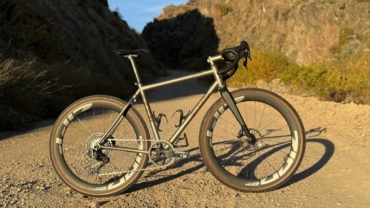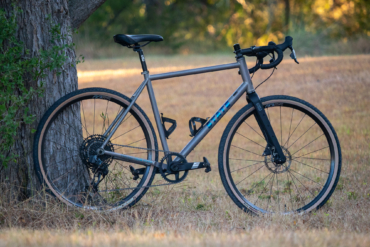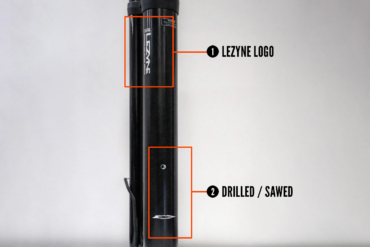Ask a cyclist what kind of bike frame to buy and you can plan on a long conversation. What kind of bike? Are you considering a road, mountain, triathlon, cyclocross, or fat bike? And the biggie: Steel, aluminum, carbon, or titanium?

According to cycling historians, the first bike was constructed in 1817 completely of wood. Soon after came steel, then aluminum alloy, space-age carbon fiber, and now titanium.
All four construction methods have passionate and loyal followers who scoff at anything other than their preferred material. The formula to determine the “best frame material” has a number of variables. The relationships between cost, riding style, surface, distance, and feel all influence choice.
Steel: Strong, Durable, Heavy

More bikes have been constructed from steel than any other material. When Schwinn dominated the American cycling market in the mid-20th century, iconic models like the 10-speed Varsity and the cool Sting Ray had steel frames.
From a frame builder’s perspective, welding steel tubes results in a durable, strong, long-lasting bike. For riders, steel dampens rough road surfaces that can batter your hands, crush your legs, and make a century ride miserable. Steel frames can take all kind of abuse and are relatively easy to repair. Finally, steel is less expensive than the other frame options.
For all the positive attributes steel has to offer, it has a very large negative: It’s heavy.
In a race, a steel frame represents a significant competitive disadvantage.
For some riders, steel is still the preferred frame material, but in a racing environment where ounces matter, aluminum and other materials captured racers’ attention.
A final negative: Steel can rust. Be wary if you live in a climate with lots of rain or where winter riding is pursued. Steel is fine in these situations as long as it’s cleaned and maintained, but it requires more care than other materials.
Aluminum: Light, Stiff, Perishable

Longtime cyclists recall the oversized oval aluminum tubes introduced on bikes from Klein and Cannondale. Frames constructed from aluminum alloys are lighter and less dense than steel without sacrificing stiffness. The trade-off?
For one, aluminum frames are less durable than steel. Spill an aluminum frame on a gravel-strewn road and repairs will challenge even the most skilled bike mechanic. Aluminum just can’t be welded or bent back to an original shape.
Aluminum can also be a harsher ride than steel. It tends to translate a lot of road vibration to the rider, which can lead to more fatigue after lots of miles on the bike.
For high-end road and racing bikes, aluminum frames are a strong option when weight influences performance. In many cases, bike brands will offer both aluminum and carbon frame options to fit a range of riders’ budgets.
Aluminum is extremely popular for full-suspension mountain bikes, where its ability to be formed into many shapes, and its weight to strength ratio, make it a solid choice for builders.
Titanium: Powerful, Impervious, Expensive

Bike builders never stop exploring and experimenting. For riders, the results are bike frames that push the standards of performance. Titanium offers some intriguing possibilities. Lighter than steel and more durable than aluminum, titanium represents the best of both worlds.
For riders above the snow belt who are comfortable pedaling year-round, titanium brushes off corrosive elements like road salt. You won’t find rust spots on a titanium frame. In fact, most titanium frames aren’t painted, letting the inherent beauty of the metal shine through.
Heavier riders will appreciate a titanium frame’s ability to dampen the bumps, rattles, and rough roads encountered on century tours, gravel races, and daily commutes. Like steel, a well-constructed titanium frame will last a lifetime. Aluminum and carbon just can’t live up to that guarantee.
On the downside, building a titanium frame requires skill and experience. Repairs, if needed, can be difficult. Finally, titanium frames cost significantly more than comparable steel models.
Carbon: Ultralight, Rigid, Fallible

In 1998, Marco Pantini captured the yellow jersey at the Tour de France riding an aluminum-frame Bianchi racing bike – for the last time. From that point forward, every winning bike has been constructed of carbon fiber. Noted for its light weight, stiffness, and strength, carbon fiber frame designs can be tailored to very specific applications. Tour de France time trial bikes and high-end triathlon models are good examples of frame designs enhancing race performance.
As early construction processes were evolving, carbon frames experienced issues with reliability. Inconsistencies lead to cracks and frame failures. As production methods improved, these issues have been resolved. Major bicycle brand flagship models are usually equipped with carbon fiber frames.
Like the other frame options, carbon has its weaknesses. Durability is one question. A crash that might scratch the paint on a steel frame could cause significant, hard-to-repair damage to a carbon frame. Since carbon fiber frames are generally more rigid than other materials, these stresses can lead to structural failures while in motion. A rare event, but not something a rider would encounter riding steel or titanium frames.
High end mountain bikes also take advantage of carbon, and here it is again a wonderful frame material. The biggest pitfall for mountain bikes is durability (big crashes can send that pricy frame flying into boulder fields) and price.
While still expensive overall, prices of carbon bikes have dropped over time and weekend warriors willing to defer saving for retirement can find a carbon frame priced within reach.
So, what’s your bike of choice: steel, aluminum, titanium, or carbon fiber? Let the debate begin.






